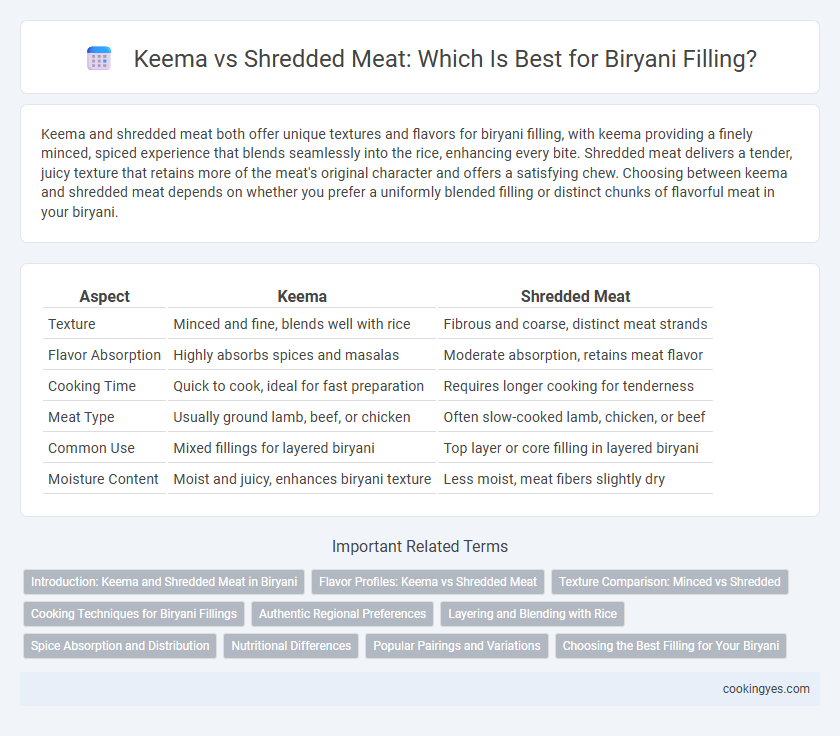Keema and shredded meat both offer unique textures and flavors for biryani filling, with keema providing a finely minced, spiced experience that blends seamlessly into the rice, enhancing every bite. Shredded meat delivers a tender, juicy texture that retains more of the meat's original character and offers a satisfying chew. Choosing between keema and shredded meat depends on whether you prefer a uniformly blended filling or distinct chunks of flavorful meat in your biryani.
Table of Comparison
| Aspect | Keema | Shredded Meat |
|---|---|---|
| Texture | Minced and fine, blends well with rice | Fibrous and coarse, distinct meat strands |
| Flavor Absorption | Highly absorbs spices and masalas | Moderate absorption, retains meat flavor |
| Cooking Time | Quick to cook, ideal for fast preparation | Requires longer cooking for tenderness |
| Meat Type | Usually ground lamb, beef, or chicken | Often slow-cooked lamb, chicken, or beef |
| Common Use | Mixed fillings for layered biryani | Top layer or core filling in layered biryani |
| Moisture Content | Moist and juicy, enhances biryani texture | Less moist, meat fibers slightly dry |
Introduction: Keema and Shredded Meat in Biryani
Keema, finely minced meat, infuses biryani with a rich, uniform texture that blends seamlessly with aromatic spices. Shredded meat offers a chunkier, fibrous bite that retains distinct flavor pockets throughout the dish. Both fillings highlight regional preferences and cooking techniques, enhancing biryani's savory complexity.
Flavor Profiles: Keema vs Shredded Meat
Keema offers a rich, spiced flavor profile with finely ground meat that absorbs aromatic spices thoroughly, creating a uniform taste throughout the biryani. Shredded meat provides a more textured bite with distinct pieces that retain their individual seasoning, resulting in bursts of flavor with every mouthful. The choice between keema and shredded meat ultimately impacts the biryani's depth and mouthfeel, catering to preferences for either cohesive spice integration or varied meat texture.
Texture Comparison: Minced vs Shredded
Minced keema offers a fine, crumbly texture that blends seamlessly with rice, creating a uniform mouthfeel in biryani. Shredded meat provides a fibrous, tender bite that contrasts with the grain, adding distinct layers of texture. The choice between minced and shredded fillings affects the biryani's overall sensory experience, influencing juiciness and chewiness.
Cooking Techniques for Biryani Fillings
Keema, made from finely minced meat, requires quick sauteing with spices to ensure even flavor absorption and tender texture, making it ideal for richly spiced biryanis. Shredded meat, usually slow-cooked and shredded from whole cuts, benefits from longer marination and simmering to retain moisture and develop deep, layered flavors in the biryani. Both techniques emphasize precise cooking times and spice infusion methods to balance texture and aroma, crucial for authentic biryani fillings.
Authentic Regional Preferences
Keema, finely minced meat, is traditionally preferred in North Indian and Mughlai biryanis for its ability to blend seamlessly with spices, offering a rich and uniform flavor throughout the dish. Shredded meat, more common in Hyderabadi and South Indian biryanis, provides a distinct texture and robust meat presence that enhances the complexity of regional spice blends. These regional preferences highlight the cultural diversity within biryani recipes, emphasizing texture and flavor profiles unique to each culinary tradition.
Layering and Blending with Rice
Keema offers a finer texture that blends seamlessly with biryani rice, allowing for even distribution and enhanced absorption of spices throughout each layer. Shredded meat provides distinct, tender strands that create richer, more textured layers, offering bursts of flavor between the rice grains. Both fillings impact the biryani layering by influencing moisture retention and flavor integration, with keema favoring a cohesive taste and shredded meat emphasizing textural contrast.
Spice Absorption and Distribution
Keema, being finely minced, offers superior spice absorption, allowing the aromatic flavors to penetrate evenly throughout each bite of biryani. Shredded meat, with its fibrous texture, tends to retain spices on the surface but provides less uniform flavor distribution compared to keema. This difference significantly impacts the overall taste experience, with keema biryani delivering a more consistent blend of spices.
Nutritional Differences
Keema, made from finely ground meat, typically contains higher fat content and is easier to digest compared to shredded meat, which retains more muscle fibers and offers greater protein density and fiber. Shredded meat provides a richer texture and may have slightly reduced saturated fats due to the meat's muscle structure, resulting in a leaner nutrient profile. Both options supply essential amino acids and iron, but keema's finer consistency can lead to quicker absorption of nutrients in biryani dishes.
Popular Pairings and Variations
Keema, finely minced meat, pairs exceptionally well with aromatic spices like cardamom and cloves, creating a rich and flavorful Biryani filling often complemented by peas or potatoes. Shredded meat offers a textured alternative, absorbing robust flavors from ingredients such as yogurt and saffron, making it ideal for variations like Hyderabadi or Lucknowi Biryani. Popular pairings emphasize regional spice blends and accompaniments like fried onions or boiled eggs to enhance the distinct taste profiles of both Keema and shredded meat biryanis.
Choosing the Best Filling for Your Biryani
Keema, finely minced meat, blends seamlessly with spices and rice, creating a uniform texture ideal for traditional biryani. Shredded meat offers a chunkier bite and a richer, meat-forward flavor that stands out against the aromatic rice layers. Selecting the best filling depends on texture preference and the desired intensity of meat flavor in your biryani.
Keema vs Shredded Meat for Biryani filling Infographic

 cookingyes.com
cookingyes.com